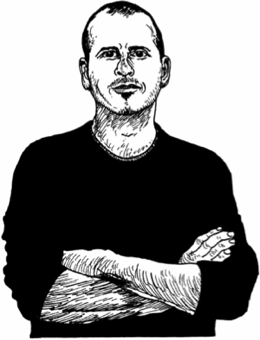In the October Issue:
Sheila Heti’s interview with Toronto-based Artist, Micah Lexier.
BLVR: Can I ask you about A Portrait of David?
ML: Sure.
BLVR: So in 1993 you shot seventy-five people named David, from ages one to seventy-five. What was your interest in making it? I see that project as classifying. Was it about saying, “Okay,this is fourteen, this is fifteen, this is sixteen”? Was it emotionally satisfying to make?
ML: Yeah, it was shockingly satisfying. The first project was about my interest in increments, my interest in observing what it means to be alive and what does it mean to grow up? It’s this play between the specific and the general. Because each David is also just himself. David age one was just “David Smith” at age one. But when you line up all these very specific Davids, you’re able to make generalizations. Here is the ad in the paper looking for people named David.
BLVR: What city is this? Winnipeg?
ML: Winnipeg. So it’s a portrait of Winnipeg. This idea of portraiture is a big part of my work.
BLVR: It’s like with Ampersand, where you created the seventeen thousand tiles that lined the Sheppard and Leslie subway station from pieces of paper you handed out to commuters, asking them to write “Sheppard” and “Leslie.” I love that piece so much. I love being in that subway. You can be in there for hours, just thinking about individuality.
ML: Right. It’s a kind of portrait of the people who participated. Again, it’s the increment of the individual−
BLVR: Same with the Colm Tóibín story.
ML: Right, it’s a portrait of the school but each individual contributes their little increment. Everyone presides over their own work, but when you look at the whole thing, it’s a portrait of the school—or Toronto—or Winnipeg. [We begin looking through the book of the follow-up project, called David Then & Now, which shows each David as he was when the project was first shot, then each David ten years later.]
BLVR: Is your dad’s name David?
ML: No, but I asked my dad for help when we couldn’t find a David aged sixty-seven. “Do you not know any guys named David?” I asked him. He was like, “Oh, well, there’s David so-and-so,” and I was like, “Dad, will you call him and see if he’ll do it?” And he did it, but the guy was such a fucking grouch. He came in—you’ll see. He had his galoshes on. He wouldn’t take his galoshes off, and he’s like, “I’m only doing this as a favor for your dad. Your dad’s a nice guy; I’m doing it for...
You have reached your article limit
Sign up for a digital subscription and continue reading all new issues, plus our entire archives, for just $1.50/month.
Already a subscriber? Sign in





